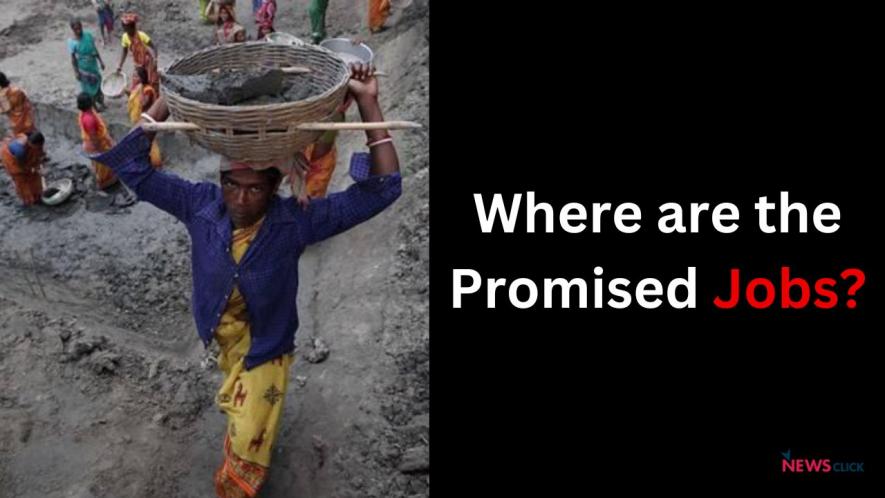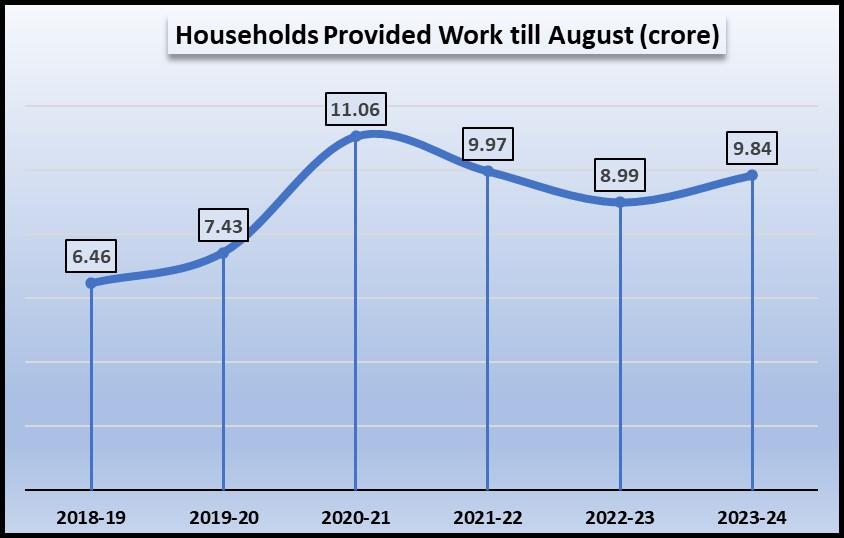MGNREGS: Rising Demand Shows Jobs & Earnings Crisis

In what is a sign of dire crisis, work demand in the rural jobs guarantee scheme (MGNREGA) has almost reached 2021 level by July this year. Remember: 2021 was the second year of the pandemic which saw a jump in demand after the deadly second wave of Covid. For the first four months of the financial year 2023-24, that is, April to July 2023, 9.84 crore households worked in the scheme, up by almost 10% over the same period last year, and close to 9.97 crore in 2021, according to government data. (See chart below)

The Covid years of 2021 and 2022 had shown surging demand as lockdowns and the devastation caused by the pandemic slowed down the economy, with mass migration taking place from urban areas to villages. The pandemic has abated but the work demand under MGNREGA has again risen after a dip last year.
The scheme offers 100 days of labouring jobs in rural works. However, official data shows that average number of days of work actually provided was about 48 last year and it has remained around 50 days for the past several years while average wage has remained abysmal – it was Rs.217.91 per day last year and Rs.208.84 the year before that.
Despite the drudgery, the low wages and the sporadic nature of work amounting to about 50 days in a year, the scheme remains a lifeline for crores of desperate rural households seeking to somehow supplement their earnings to make ends meet.
Reflects Lack of Jobs and Low Earnings
Why is there such a high demand for work in the scheme? The primary reason is that India’s economy is unable to provide jobs to a large section of the working age population. According to CMIE (Centre for Monitoring Indian Economy), the unemployment rate has hovered around 7-9% for the past several years, shooting up in the pandemic period but settling back in this range afterwards. There is a high degree of seasonality in employment in rural areas because agriculture continues to be the main source of work. This is reflected in the MGNREGS work pattern also – work demand goes up in the summer months after the rabi harvest and then dips again when the kharif sowing begins with the coming of monsoon rains.
Another related factor for high demand for work in the scheme is that earnings are very low whether in agriculture related work or in non-farm work, or even self-employment.
The Economic Survey for 2022-23, revealed that real wages – that is, wages adjusted to inflation – of rural labourers are either stagnating or showing marginal fall over the past over two years. An earlier survey had noted that there are about 36.5 crore workers in rural India out of which some 61.5% are employed in agriculture, 20% in industry and 18.5% in services.
The last Periodic Labour Force Survey (PLFS) for the period April 2020 to March 2021 had said that in rural areas, the predominant share of households (55%) is self-employed, largely in agriculture. This is followed by casual labour (24%), which is often seasonal and irregular work on daily wages. Regular, salaried workers make up just 13% of rural households. Among the self-employed, on an average, rural men earn Rs.10,228 per month while women get get less than half of that that (Rs.4,561). Casual workers who work for daily wages and suffer very onerous working conditions are the least paid of all. Even in urban areas, a male casual worker will earn just Rs.10,058 per month while the female worker will get just Rs.6,608. In urban areas, earnings are slightly better at Rs.12,360 for men and Rs.8,145 for women. These monthly wages for casual workers are projected from daily earnings data that was collected in the PLFS. In reality, there will be days when there is no work interspersed with days of work.
The result of this extremely low levels of incomes is that people often do many different types of work in order to increase their incomes. Working in MGNREGS is one of the many options and they readily accept work in the scheme, as and when offered.
In fact, this subsistence level of economy is the primary reason for low consumption expenditure which in turn depresses demand and thus pulls down industrial production too. The whole cycle of a slowing economy is thus linked to the crucial fact that there is no buying power in the hands of the vast mass of people in India.
Govt. Continues to Underfund MGNREGS
One would have thought that the least the central government would do is to provide some relief to people by strengthening and expanding the rural jobs guarantee scheme. More money would mean more jobs for more people. But paralysed by its ideological commitment to the neoliberal dogma that government should spend as little as possible and allow the private sector to run the show, it has been trying to starve the scheme of funding. The Government has adopted a bizarre strategy of initially allocating less than needed amount in the Budget Estimates (BE) and then, after much hue and cry, increasing it as the year progresses. Even then, the Revised Estimates (RE) ends up at less than required allocation.
Responding to criticism by the Parliamentary Standing Committee on Rural Development and Panchayati Raj for this continued deficient allocation, the Department of Rural Development had said “In the FY 2019-20, BE was Rs.60,000 crore which got revised to Rs.71,001.81 crore, for the FY 2020-21, BE was 61,500 crore which increased at RE to Rs.1,11,500 crore and for the FY 2021-22, the BE of Rs.73,000 crore has revised been to Rs.98,000 crore and during the last Financial Year 2022-23, the BE was Rs.73,000 crore, which has been revised to Rs.89,400 crore”. This was recorded in the 33rd Report of the Committee.
For 2023-24, the Committee pointed out that the Department had itself proposed an allocation of Rs.98,000 crore but the Finance Ministry had cut it down to Rs.60,000 crore!
Reacting sharply to this situation, the Committee pointed out that for 2023-24, the BE of Rs.60,000 crore was less than the RE for the previous year by a whopping Rs.29,400 crore. It went on to say, “Taking stock of the situation, the Committee find such reply of the Department extremely stereotypical and routine in nature. The Department of Rural Development neither provided concrete reply to the query of the Committee as to how the DoRD arrived at the calculation of Rs. 98,000/- Crore as the BE for MGNREGA at the proposed demand stage, nor it is able to put forward any concrete mode of action to deal with the probable dearth of funds under MGNREGA at this point of time. The Committee are not satisfied with the approach elicited by the DoRD in handling an issue of such importance which could lead to the hampering of the work being done under MGNREGA due to fund shortage. Such a scenario will not augur well for the poor rural workers under MGNREGA as want of funds could stall the projects creating pendency of wages, etc. In view of the above, the Committee strongly reiterate their recommendation and urge upon the DoRD to handle the fund related aspect of MGNREGA with a much informed and robust financial pragmatism…”
These exchanges give a snapshot of the stubborn approach of the government in the face of criticism even by the Standing Committee while revealing that the shots are being called by the mandarins in Finance ministry.
Be that as it may, the country faces a dire and explosive employment crisis and the government appears to be sticking its head in the sand.
Get the latest reports & analysis with people's perspective on Protests, movements & deep analytical videos, discussions of the current affairs in your Telegram app. Subscribe to NewsClick's Telegram channel & get Real-Time updates on stories, as they get published on our website.
























